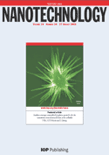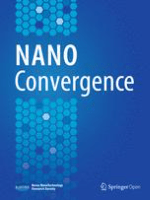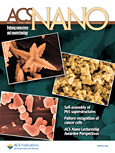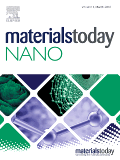
NANOTECHNOLOGY
Scope & Guideline
Pioneering Research in Nanotechnology and Beyond.
Introduction
Aims and Scopes
- Nanomaterial Synthesis and Characterization:
The journal covers innovative methods for synthesizing nanomaterials, including chemical vapor deposition, sol-gel processes, and green synthesis techniques. Characterization techniques such as electron microscopy, X-ray diffraction, and spectroscopy are also emphasized. - Nanotechnology Applications in Medicine:
Research on the use of nanomaterials for drug delivery, imaging, and therapeutics is a core focus, highlighting advancements in targeted therapy and diagnostics. - Nanotechnology for Energy Applications:
The journal publishes studies related to the application of nanomaterials in energy conversion and storage, including solar cells, batteries, and supercapacitors, emphasizing their potential for improving efficiency. - Environmental Nanotechnology:
Research addressing the environmental implications of nanotechnology, including the development of nanomaterials for pollution remediation and sustainable practices, is an essential aspect of the journal. - Nanotechnology in Electronics and Sensors:
The journal features advancements in nanoelectronics, sensors, and devices, focusing on the integration of nanomaterials to enhance performance and miniaturization.
Trending and Emerging
- Sustainable and Green Nanotechnology:
Research focusing on environmentally friendly synthesis methods and applications of nanomaterials for sustainability, such as pollution remediation and energy efficiency, is on the rise. - Nanotechnology for Biomedical Applications:
There is an increasing trend towards the development of nanomaterials for biomedical use, including drug delivery systems, imaging agents, and cancer therapies, highlighting the intersection of nanotechnology and healthcare. - Advanced Characterization Techniques:
Emerging methodologies for characterizing nanomaterials, including in situ techniques and advanced electron microscopy, are gaining prominence, reflecting the need for precise analysis of nanoscale structures. - Integration of AI and Machine Learning:
The application of artificial intelligence and machine learning in nanotechnology research, from material discovery to device optimization, is a rapidly growing area of interest. - Hybrid Nanostructures and Composites:
There is a notable increase in research on hybrid nanostructures that combine various nanomaterials to enhance performance in applications like catalysis, energy storage, and sensor technology.
Declining or Waning
- Traditional Bulk Material Studies:
Research centered on bulk materials as opposed to nanostructured materials has been declining, as the focus shifts towards the unique properties and applications of nanomaterials. - Limited Focus on Purely Theoretical Studies:
There is a waning interest in solely theoretical papers without experimental validation, as the journal increasingly favors studies that demonstrate practical applications or experimental results. - Decreased Emphasis on Conventional Chemical Methods:
Papers that rely on traditional non-green chemical synthesis methods are becoming less common, reflecting a shift towards more sustainable and environmentally friendly approaches.
Similar Journals

Micro & Nano Letters
Exploring the future of materials at the nanoscale.Micro & Nano Letters is a prominent open-access journal published by WILEY, dedicated to advancing the fields of micro and nanoscale science and technology. Since its inception in 2007, the journal has been a valuable resource for researchers, professionals, and students, delivering high-quality research that supports innovation and collaboration in bioengineering, biomedical engineering, condensed matter physics, materials science, and nanoscience. With an impact factor that reflects its growing influence, Micro & Nano Letters has earned recognition in various Scopus categories, including a Q3 ranking in both Condensed Matter Physics and Materials Science as of 2023. Its commitment to open access, established in 2021, ensures that the latest developments in micro- and nanotechnologies are accessible to a global audience, fostering a multidisciplinary dialogue across academia and industry. The journal continues to play a critical role in disseminating cutting-edge research and promoting technological advancements worldwide.

Nano Convergence
Pioneering interdisciplinary research for a nano-powered future.Nano Convergence is a premier open access journal dedicated to the rapidly evolving fields of nanotechnology, materials science, and engineering. Published by SPRINGER, this journal has been at the forefront of interdisciplinary research since its inception in 2014, and is set to continue its journey until 2024. With an impressive impact factor and recognition as Q1 in both Engineering (miscellaneous) and Materials Science (miscellaneous) categories, Nano Convergence ranks among the top publications, listed as Rank #8 out of 307 in General Engineering and Rank #34 out of 463 in General Materials Science according to Scopus metrics. This journal provides a platform for researchers, professionals, and students to share pioneering studies that converge different disciplines within nanotechnology. With its commitment to open access, Nano Convergence ensures that cutting-edge research is readily available to the global community, fostering innovation and collaborative advancements in the field.

DIAMOND AND RELATED MATERIALS
Exploring the brilliance of diamond research.DIAMOND AND RELATED MATERIALS, published by Elsevier Science SA, serves as a premier international platform for the dissemination of high-quality research in the fields of materials science, electrical engineering, and chemistry, with a specialized focus on diamond and its related materials. With an ISSN of 0925-9635 and an E-ISSN of 1879-0062, this journal has established itself within the top quartiles, reflecting its influential contribution to the scientific community, particularly in the categories of Chemistry (miscellaneous) and Electrical Engineering, among others. The journal's wide scope encompasses both theoretical and applied aspects of diamond research, making it an essential resource for professionals and academics alike. The current rankings position it favorably within its respective disciplines, with a notable 79th percentile in General Physics and Astronomy and strong standings in related categories. Although it does not offer open access, researchers can stay informed of cutting-edge advancements and methodologies through its comprehensive articles and reviews, enriching the wider discourse in advanced materials research.

ACS Nanoscience Au
Advancing the Frontiers of NanoscienceACS Nanoscience Au, published by the American Chemical Society, is a leading open-access journal dedicated to the rapidly evolving field of nanoscience. Since its inception in 2021, this journal has established itself within the top quartiles of academic publishing, ranking Q1 in both Chemistry and Materials Science for 2023. With a commitment to disseminating high-quality research, it provides a platform for innovative findings in nanomaterials, nanotechnology applications, and associated interdisciplinary studies. The journal is based in the United States and embraces an open-access model, ensuring that research is freely accessible to a global audience. This initiative not only enhances the visibility of authors' work but also facilitates collaboration across scientific domains. As a vital resource for researchers, professionals, and students alike, ACS Nanoscience Au plays a crucial role in advancing knowledge in the nanoscience community.

JOURNAL OF MATERIALS SCIENCE-MATERIALS IN ELECTRONICS
Unveiling Breakthroughs in Electronic Materials ResearchJOURNAL OF MATERIALS SCIENCE-MATERIALS IN ELECTRONICS, published by Springer, is a distinguished international journal that serves as a vital platform for the dissemination of cutting-edge research in the field of materials science, with a keen focus on electronics. Since its inception in 1990, this journal has consistently contributed to the advancement of knowledge across a range of interdisciplinary categories, including Atomic and Molecular Physics, Optical and Magnetic Materials, and Biomedical Engineering, achieving notable quartile positions in various 2023 Scopus rankings. With an impact factor that signifies its scholarly influence, this journal provides a rigorous peer-reviewed environment for researchers and practitioners to share innovative ideas, experimental findings, and theoretical developments. Although it does not currently offer open access options, the depth and breadth of topics covered—including condensed matter physics and bioengineering—make it an essential resource for those at the forefront of materials research. With a commitment to bridging the gap between theory and practical application, the JOURNAL OF MATERIALS SCIENCE-MATERIALS IN ELECTRONICS continues to pave the way for future explorations in the ever-evolving landscape of materials science.

Nanoscale Research Letters
Innovating at the nanoscale for a brighter tomorrow.Nanoscale Research Letters, published by SPRINGER, is a leading open-access journal dedicated to the rapid dissemination of innovative research in the field of nanoscience and nanotechnology. Established in 2006, this journal provides researchers and professionals with a platform to share their groundbreaking findings across a broad spectrum of applications, including condensed matter physics and materials science. With an impressive Q1 ranking in both Condensed Matter Physics and Materials Science categories as of 2023, it asserts its position as a top-tier publication within the scientific community, bolstered by a 96th percentile rank in the Scopus database. Nanoscale Research Letters not only emphasizes the importance of nanotechnology research but also ensures that its findings are widely accessible, adhering to its open-access mandate. Scholars and students alike are encouraged to contribute to and engage with this dynamic resource, fostering collaboration and innovation in the ever-evolving world of nanoscience.

MRS Advances
Connecting Ideas, Inspiring InnovationsMRS Advances, published by Springer Heidelberg, is an esteemed academic journal that serves as a vital platform for disseminating cutting-edge research in the fields of condensed matter physics, materials science, and mechanical engineering. With an ISSN of 2731-5894 and an E-ISSN of 2059-8521, the journal is hosted in Switzerland and encompasses an impressive spectrum of innovative studies that impact both theoretical and practical applications. Throughout its converged years from 2012 and continuing through 2024, MRS Advances has established itself with notable rankings, including Q4 in condensed matter physics and Q3 in several related categories. This journal not only enriches the academic community with its rigorous peer-reviewed articles, but also encourages open discussions that further advance research innovations. Although currently not designated as an open-access journal, its accessibility through institutional subscriptions ensures that professionals, researchers, and students can engage with the latest advancements in the material science arena. Emphasizing its relevance, MRS Advances is dedicated to fostering interdisciplinary collaboration and inspiring new discoveries within the global research community.

ACS Nano
Transforming Knowledge into Nanotechnology BreakthroughsACS Nano, published by the American Chemical Society, stands as a prestigious journal in the domains of Engineering, Materials Science, Nanoscience, and Physics. With an exceptional impact factor reflecting its standing as a Q1 category journal in multiple disciplines, it plays a pivotal role in disseminating groundbreaking research from 2007 to 2024. Known for its rigorous peer-review process, the journal boasts impressive Scopus rankings—positioned at #1 in General Engineering and #6 in General Physics and Astronomy—placing it among the top 1% of journals in its field. Although it is not an open-access publication, ACS Nano provides a wealth of knowledge that is essential for advancing the development of nanotechnology and its applications across various industries. Researchers, professionals, and students alike will find in its pages a trove of innovative studies and insights that drive the future of materials science and engineering.

Materials Today Nano
Empowering Knowledge in Nano-Materials for Global ImpactMaterials Today Nano, published by Elsevier, is a premier academic journal dedicated to the forefront of nano-materials research, encompassing innovations and advancements in biomaterials, condensed matter physics, electronic, optical, and magnetic materials, as well as materials chemistry. With an impressive Q1 ranking across multiple categories, including biomaterials and materials chemistry, this journal serves as a essential platform for researchers, professionals, and students aiming to contribute to and stay informed on cutting-edge developments that push the boundaries of materials science. Its open access model allows for wider dissemination of high-impact findings, ensuring that the research reaches a global audience. Operating from the United Kingdom, Materials Today Nano plays a vital role in fostering interdisciplinary collaboration and advancing scientific understanding in this rapidly evolving field.

JOURNAL OF MATERIALS SCIENCE
Transforming Knowledge into Advanced ApplicationsJOURNAL OF MATERIALS SCIENCE, published by SPRINGER, stands as a highly regarded periodical in the field of materials science, delivering impactful research since its inception in 1966. With an impressive Q1 ranking in both Mechanical Engineering and Mechanics of Materials, alongside strong Q2 positions in Ceramics, Composites, and General Materials Science, this journal serves as a pivotal resource for scholars and practitioners alike. It offers insightful contributions that span a diverse range of topics, from emerging materials to advanced applications in engineering. With a robust Scopus ranking reflecting its global influence—ranking 91 out of 672 in Mechanical Engineering and 63 out of 398 in Mechanics of Materials—the JOURNAL OF MATERIALS SCIENCE maintains an essential role in advancing the understanding and innovation within the discipline. Researchers, professionals, and students are encouraged to access this esteemed journal to keep abreast of groundbreaking findings and methodologies that shape the future of materials science.